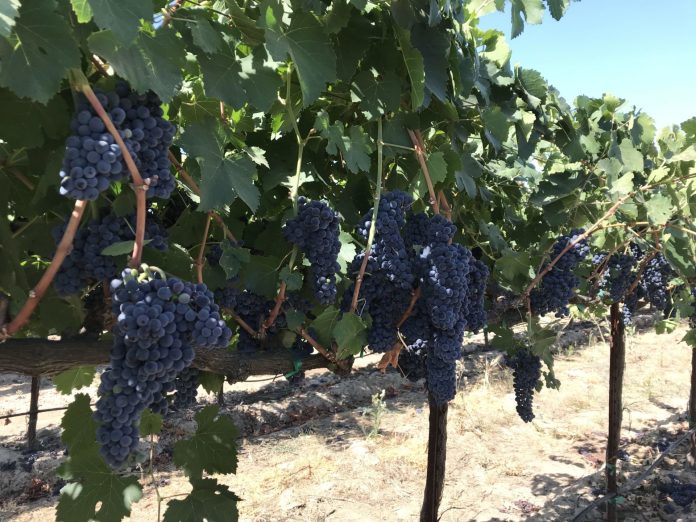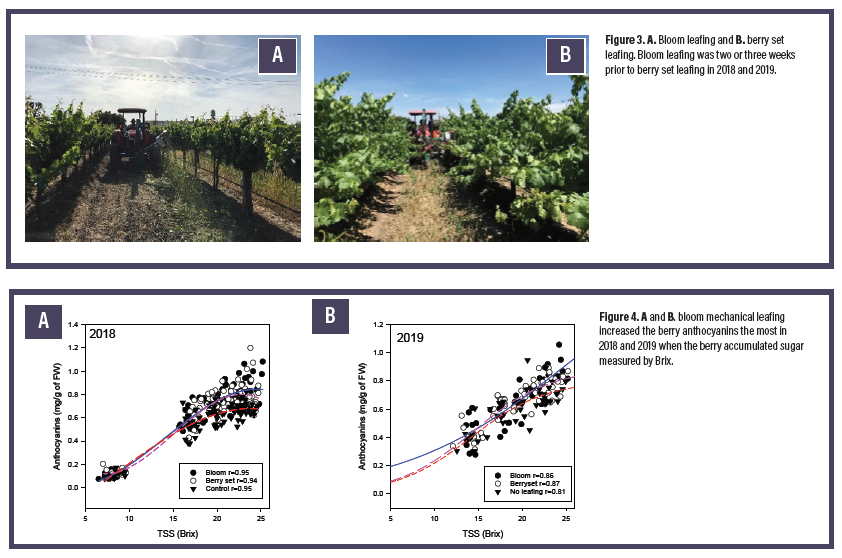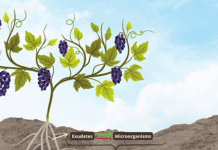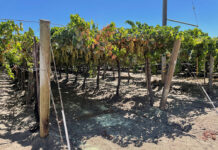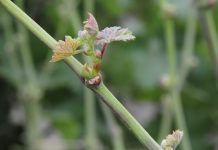Early season vineyard management is critical for several reasons. First, the grapevine microclimate and fungal disease severity at early season largely affect the yield, e.g., yield loss and fruit unmarketability due to fungal disease, and fruit quality, e.g., Brix and color for red varieties; second, some missteps in early season vineyard practices might hinder the following year’s success if they affect bud fruitfulness; finally, optimal early management might save you money on pest/disease management.
The season starts at budbreak and once buds start to push, the clock begins clicking. Although several vineyard practices during grapevine dormancy might also be important, such as pruning and fungicide application (e.g., lime sulfur), I will focus on post-budbreak vineyard management in this article.
The most important steps during early season vineyard management include:
- Irrigation
- Nutrition
- Pest/disease
- Canopy management
- Crop management
The objectives of early season vineyard management are simple and straightforward: To sustain yield with desired fruit quality at harvest with low disease/pest pressure. Irrigation, grapevine nutrition, pest/disease pressure, canopy management, and crop level all play in the formula to decide the timing and severity of vineyard practices at the early growing stage.
Irrigation
According to retired UCCE Viticulture Specialist Dr. Larry Williams, in a year with normal winter rainfall, a typical San Joaquin Valley (SJV) vineyard might not require irrigation until bloom, which might be approximately late April or early May in the SJV depending on weather, site, variety, and other farming practices. However, the timing of first irrigation can vary dramatically based on the winter and spring precipitation. Too much irrigation or precipitation at an early canopy development stage can promote rapid shoot growth and create a large and dense canopy which increases shading and relative humidity (RH) inside the canopy favoring fungal diseases, such as phomopsis, botrytis, and powdery mildew.
Canopy management such as shoot thinning, leafing and cane trimming can alleviate some negative effects from excessive vigor or dense canopy. However, canopy management alone might not offer the complete solution if the excessive growth resulted from too much precipitation or irrigation. Understanding when and how much to irrigate is beyond the scope of this article. However, some basic tools, such as visual assessment and soil moisture meter, can generally serve the purpose of deciding when to irrigate. Other irrigation scheduling tools, e.g., crop evapotranspiration (ETc), can also offer information on how much to irrigate on a daily or weekly basis. Managing irrigation and adjusting the canopy accordingly can optimize yield and fruit quality, along with the effectiveness of fungicide/pesticide programs, and that will improve your profit and reduce your fungicide/pesticide costs.
Nutrition
Managing grapevine nutrition serves two purposes: First, to make sure there are no nutrient deficiencies that could limit yield level or fruit quality; second, to make sure there are no excessive or even detrimental levels of nutrients that could also lead to reduced yield potential and fruit quality, unnecessary expense, and unwanted effects on the environment. Among grape nutrients, N has the most impact on vine vigor and canopy growth. Excessive N either from fertilizer application or irrigation water can promote excessive canopy growth causing shading and high RH inside of the canopy. As a result, excessive shading can impact the fruit-zone microclimate, and create high RH, favoring fungal disease, which will reduce fruit quality/marketability and basal bud fruitfulness for the following year’s crop.
Opening the canopy by shoot thinning, leafing and cane trimming can increase the exposure of basal buds and clusters and improve spray coverage and air circulation. However, like irrigation, canopy management might not be enough to correct the negative impact resulting from excessive N status, if N is left unchecked, an oversupply of N will promote the canopy growth to diminish any benefit from canopy management.
Growers should conduct a visual assessment and consider laboratory results, and rely on historical records, like yield and pest/disease conditions, to adjust the grapevine nutrition program. Among all the measures, bloom petiole or leaf blade tests are recommended to take a snapshot of early vine nutrient status that will give growers enough time to adjust the fertilizer program accordingly. Grapevine bloom petiole critical values are published in Table 1, above. Be cautious with N critical value. The N critical value was solely established on data based on Thompson Seedless with own root. Growers should judge the grapevine N status with additional information, e.g., vine general health, vigor and yield.
Canopy Management
As I discussed previously, typical grapevine canopy management includes shoot thinning, shoot positioning, leafing and cane trimming. Based on the trellis type, growers might not need to apply all of them. Most common practices in the SJV are shoot thinning, leafing, and canopy trimming and all of them can be performed mechanically.
Shoot thinning is typically conducted when shoots are 8 to 10 inches; the objectives are to reduce shoot density and improve light exposure inside of the canopy as well as reduce the crop level. In the SJV, few growers adopted this practice due to the potential yield loss. However, shoot thinning can be beneficial when the vines are young with excessive crop or vines that have an excessive number of fruitful buds following mechanical pruning (see Figure 1, above). Shoot thinning regulates the crop load to avoid the negative impact of overcropping on berry ripening and potential carryover effect on the following year’s crop. Many researchers have shown the benefits of shoot thinning and a few have demonstrated the feasibility of mechanical shoot thinning (Geller and Kurtural 2012). However, the benefit of shoot thinning might gradually diminish during the season if the irrigation is unchecked since the canopy could recover and refill the gaps when water is abundant.
Leafing aims to increase light exposure on clusters and basal buds to improve the fruit quality and bud fruitfulness as well as improve spray coverage and lower disease pressure (Figure 2, above). Both timing and severity of leafing are critical to achieve success. Leafing after veraison typically has no or negative effect on fruit quality, especially in the SJV. Leafing around berry set is commonly recommended to improve the color of red grape varieties, and studies show better results from mechanical leafing in comparison to hand leafing. Recently, several studies including a couple in Fresno and Madera, have proven pre-bloom or bloom mechanical leafing might offer the most benefits in comparison to classical berry set leafing. Compared to berry set leafing, bloom leafing offers more or similar fruit quality benefits with less cost by eliminating the need for shoot positioning prior to leafing, since most shoots are vertically positioned at bloom (Figure 3 and 4, below).
In cool climates and less productive vine systems, pre-bloom or bloom leafing might reduce berry set and ultimately decrease yield (Achimovic. et al. 2016). However, in our study and other studies in the SJV (Cook et al. 2015), no effect on berry set and yield has been observed, and the effect on berry set and yield from leafing prior to bloom may largely depend on growing conditions and severity of leaf area reduction from leafing.
Cane trimming is used to open the canopy for light exposure and increase air circulation in order to reduce RH and fungal disease pressure when the canopy is excessive and dense. However, severe canopy trimming might result in significant loss of leaf area that can delay the berry ripening by reducing the photosynthetic productivity (Figure 5, below). Severe canopy trimming might also over-expose the cluster and cause sunburn before harvest. The goal of canopy trimming is to effectively open the canopy without severely reducing functional leaves and over-exposing the fruit.

In conclusion, canopy management should be integrated with water and nutrient management as part of early season vineyard practices paying attention to pest/disease management, growing conditions (e.g., climate, soil condition, and irrigation water availability and quality) and production goals to achieve the maximum production efficiency with low disease and pest pressure.
Reference:
Geller, J. and Kurtural, K. 2012. Mechanical Canopy and Crop-Load Management of Pinot gris in a Warm Climate. American Journal of Enology and Viticuture. 64: 65-73.
Acimovic, D., Tozzini, L., Green, A., Sivilotti, P., and Sabbatini, P. 2016. Identification of a defoliation severity threshold for changing fruitset, bunch morphology and fruit composition in Pinot Noir. Austalian Journal of Grape and Wine Research. https://doi.org/10.1111/ajgw.12235.
Cook, M., Zhang, Y., Nelson, C., Gambetta, G., Kennedy, J., and Kurtural, K. 2015. Anthocyanin Composition of Merlot is Ameliorated by Light Microclimate and Irrigation in Central California. American Journal of Enology and Viticulture. 66: 266-278











